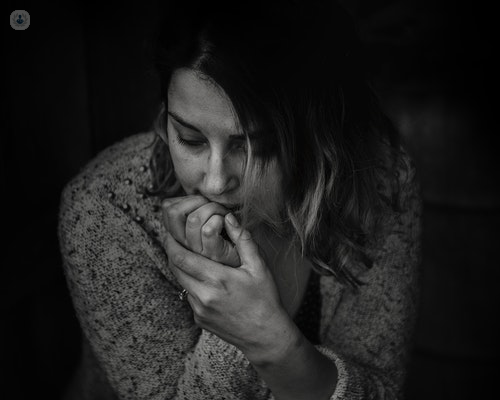Common vulval skin disorders
Written by:Consultant dermatologist, Dr Stephanie Arnold describes some of the most common skin disorders which can affect the vulva. Read on to find out the causes, symptoms and treatment options.

What are some of the most common vulval skin disorders?
There are a wide variety of vulval skin disorders, and they can be considered as specific to the vulva or more generally related to the skin.
Vulval-specific disorders are those which are mainly found in the genital area (vulva, vagina, perianal skin) – examples include lichen sclerosus, lichen planus and genitourinary syndrome of menopause, along with infections such as thrush, genital warts, and bacterial vaginosis.
General skin conditions such as eczema and psoriasis can also occur in the genital area, and it is not uncommon for these conditions to present with predominant symptoms in this area (i.e. with only mild skin findings elsewhere on the body).
- Probably the most common vulval skin disorder I see is vulval dermatitis – this can arise from several different causes including: having a tendency to atopy (eczema, hay fever, or asthma), development of an allergy to something that has been in contact with your skin, and (most commonly of all) exposure to substances that cause irritation in the genital area.
- Irritant dermatitis is very common in the genital area – it is due to exposure to irritant chemicals such as body washes, soaps, feminine hygiene products, fragrances (such as those found in sanitary towels), sweat, tight clothing and incontinence.
- Lichen sclerosus is the most common ‘vulval-specific’ condition I see in my dermatology practice.
How do they occur?
While some of the causes of genital eczema are listed above, we don’t fully know why lichen sclerosus occurs. it is more common in prepubertal girls and postmenopausal women, and is associated with other autoimmune conditions such as vitiligo, thyroid dysfunction, and B12 deficiency. Sometimes vulval itch can be caused by low iron stores, which is very easily treated with iron supplementation.
What are the symptoms?
Most vulval conditions present as either itch or soreness. Often the itch can be so severe it wakes a patient up from sleep, both in lichen sclerosus and genital eczema.
Occasionally women notice a change to their anatomy (such as reduced size of the labia minora or clitoral hood) or white patches developing on their labia – both of these things can occur with lichen sclerosus, so it is important that if these are noticed that the patient seeks a medical opinion quickly.
How are these conditions usually diagnosed?
Most often vulval conditions can be diagnosed by a doctor with a special interest in vulval dermatology simply by asking questions and performing a thorough examination. Occasionally a swab needs to be taken to confirm an infection (such as thrush).
Sometimes we need to take a biopsy of the skin to confirm a diagnosis – this is a small procedure that involves injection of local anaesthetic. It takes about 20 minutes.
How can I treat vulvar dermatitis at home?
There are many simple things you can do to treat vulvar dermatitis at home!
- First – stop using any products that could cause irritation to the area. That means stopping all soaps, bodywashes, feminine hygiene washes, vaginal ‘douches’, toileting wipes, and (if possible) avoiding sanitary towels or using an organic cotton sanitary towel. Some people also find that switching to plain cotton underwear and wearing loose clothing made from natural fibres also helps.
- Second – use a bland, non-fragranced moisturiser to wash the skin with in the shower or bath (instead of soap/body wash).
- Third – moisturise at least once a day, preferably after showering. This protects the skin and reduces the itch.
- Finally – see your doctor for a proper diagnosis and to discuss whether you need a topical steroid ointment to calm down the inflammation.
If you are experiencing one of these or any other dermatological issue, you may want to see a specialist like Dr Arnold. Visit her Top Doctors profile to request an appointment with her.


